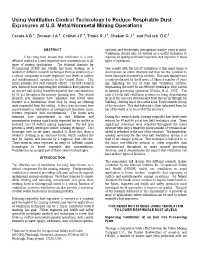Mining Publication: Using Ventilation Control Technology to Reduce Respirable Dust Exposures at U.S. Metal/Nonmetal Mining Operations
Original creation date: July 2005
It has long been known that ventilation is a cost-effective method to lower respirable dust concentrations in all types of mining applications. The National Institute for Occupational Safety and Health has been working on a number of different research techniques that use ventilation as a critical component to lower respirable dust levels at surface and metal/nonmetal operations in the United States. This article presents five such research efforts. The first research area discusses how improving the ventilation flow patterns in an iron ore mill facility lowered respirable dust concentrations by 31 pct throughout the primary grinding area. The second research area examines how respirable dust levels were lowered at a dimensional stone shop by using air cleaning units suspended from the ceiling. A third area discusses how improvements in ventilation at underground limestone mines lowered respirable dust concentrations. The fourth area examines how improvements in dust filtration and pressurization systems significantly impacted the air quality in enclosed cabs of surface mining equipment. The last area presents a newly developed clothes cleaning technique. This technique uses an air spray manifold to blow dust from a worker's clothing in an enclosed booth, which confines the dust for capture and removal by a baghouse dust collector. These research areas represent an array of different control technologies to lower respirable dust concentrations. Ventilation is an integral part of these control technologies.
Authors: AB Cecala, JA Zimmer, JF Colinet, RJ Timko, GJ Chekan, DE Pollock
Conference Paper - July 2005
NIOSHTIC2 Number: 20028290
Gillies ADS, ed. Proceedings of the Eighth International Mine Ventilation Congress, Brisbane, Queensland, Australia, July 6-8, 2005. Carlton, Victoria, Australia: Australasian Institute of Mining and Metallurgy, 2005 Jul; :157-165
See Also
- Bag and Belt Cleaner Reduces Employee Dust Exposure
- Dust Considerations When Using Belt Entry Air to Ventilate Work Areas
- Equivalency of a Personal Dust Monitor to the Current United States Coal Mine Respirable Dust Sampler
- Investigation of Coal Properties and Airborne Respirable Dust Generation
- Laboratory Evaluation of Pressure Differential-based Respirable Dust Detector Tube
- Laboratory Testing To Quantify Dust Entrainment During Shield Advance
- Lowering Respirable Dust at an Iron Ore Concentrator Plant Through Improved Ventilation Practices
- New Tools To Monitor Personal Exposure To Respirable Coal Mine Dust
- Performance of a Light Scattering Dust Monitor at Various Air Velocities: Results of Sampling in the Active Versus the Passive Mode
- Relationship of Coal Seam Parameters and Airborne Respirable Dust at Longwalls
- Page last reviewed: 9/21/2012
- Page last updated: 9/21/2012
- Content source: National Institute for Occupational Safety and Health, Mining Program


 ShareCompartir
ShareCompartir
